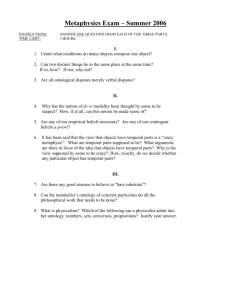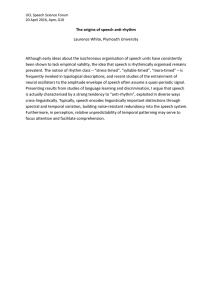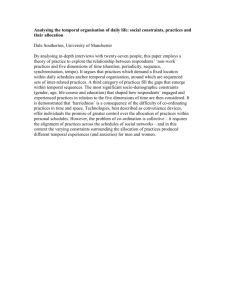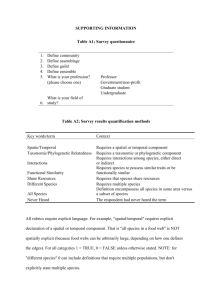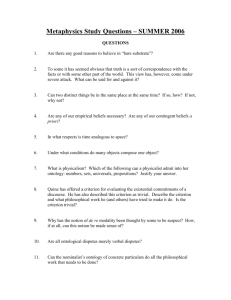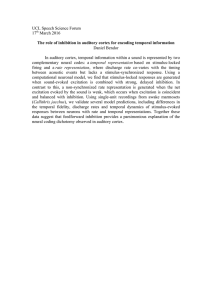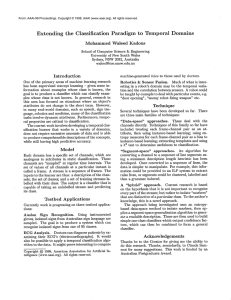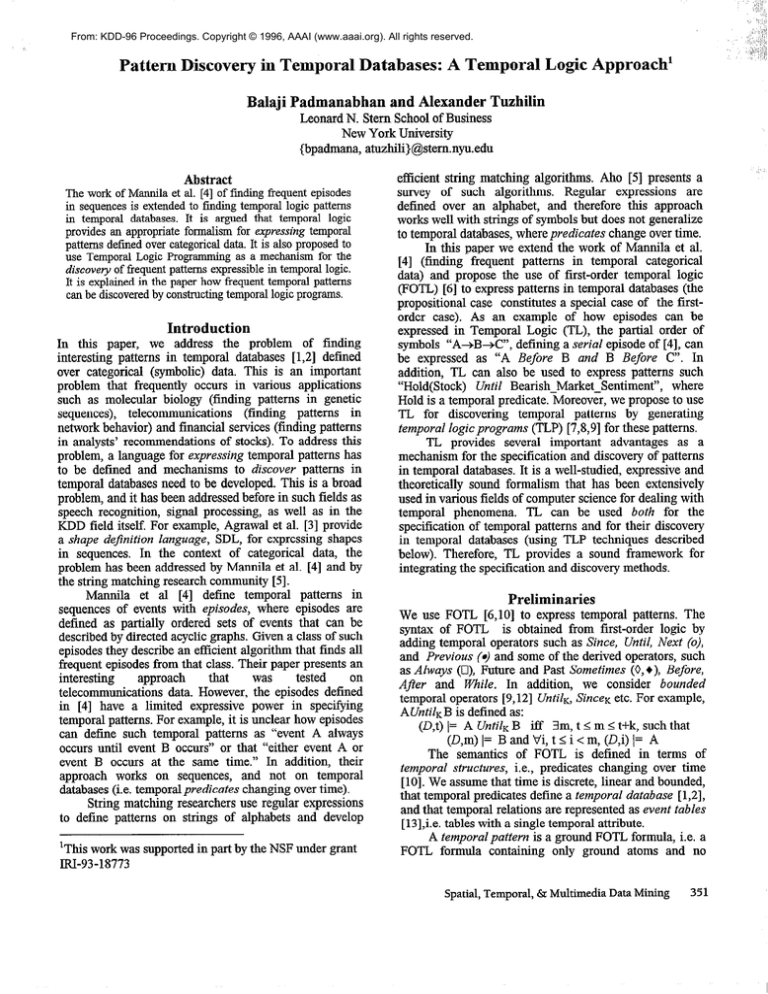
From: KDD-96 Proceedings. Copyright © 1996, AAAI (www.aaai.org). All rights reserved.
I’
Pattern Discovery in Temporal Databases: A Temporal Logic Approach’
Balaji Padmanabhan and Alexander Tuzhilin
LeonardN. Stern Schoolof Business
New York University
{bpadmana,atuzhili}@stern.nyu.edu
Abstract
The work of Mannila et al. [4] of fmding frequent episodes
in sequencesis extended to finding temporal logic patterns
in temporal databases. It is argued that temporal logic
provides an appropriate formalism for expressingtemporal
patterns defined over categorical data. It is also proposed to
use Temporal Logic Programming as a mechanism for the
discovery of frequent patterns expressible in temporal logic.
It is explained in the paper how frequent temporal patterns
can be discoveredby constructing temporal logic programs.
Introduction
In this paper, we address the problem of finding
interesting patterns in temporal databases[1,2] defined
over categorical (symbolic) data. This is an important
problem that frequently occurs in various applications
such as molecular biology (finding patterns in genetic
sequences), telecommunications (finding patterns in
network behavior) and financial services(finding patterns
in analysts’recommendationsof stocks). To addressthis
problem, a languagefor expressingtemporal patterns has
to be defined and mechanisms to discover patterns in
temporal databasesneed to be developed.This is a broad
problem, and it has been addressedbefore in such fields as
speechrecognition, signal processing, as well as in the
KDD field itself. For example, Agrawal et al. [3] provide
a shape de$nifion language, SDL, for expressing shapes
in sequences.In the context of categorical data, the
problem has been addressedby Mannila et al. [4] and by
the string matching researchcommunity [5].
Mannila et al [4] define temporal patterns in
sequencesof events with episodes, where episodes are
defined as partially ordered sets of events that can be
describedby directed acyclic graphs. Given a class of such
episodesthey describean efficient algorithm that finds all
fi-equentepisodesfrom that class. Their paper presentsan
approach that
was
tested
on
interesting
telecommunicationsdata. However, the episodesdefined
in [4] have a limited expressive power in specifying
temporal patterns.For example,it is unclear how episodes
can define such temporal patterns as “event A always
occurs until event B occurs” or that “either event A or
event I3 occurs at the same time.” In addition, their
approach works on sequences,and not on temporal
databases(i.e. temporalpredicafes changing over time).
String matching researchersuse regular expressions
to define patterns on strings of alphabets and develop
‘This work was supportedin part by the NSF under grant
IRI-93-18773
efficient string matching algorithms. Ah0 [5] presents a
survey of such algorithms. Regular expressions are
defined over an alphabet, and therefore this approach
works well with strings of symbolsbut doesnot generalize
to temporal databases,wherepredicates changeover time.
In this paper we extend the work of Mannila et al.
[4] (finding frequent patterns in temporal categorical
data) and propose the use of first-order temporal logic
(FOTL) [6] to expresspatterns in temporal databases(the
propositional case constitutesa special case of the firstorder case). As an example of how episodes can be
expressedin Temporal Logic (TL), the partial order of
symbols “A+B+C”, defining a serial episodeof [4], can
be expressed as “A Before B and B Before C”. In
addition, TL can also be used to express patterns such
“Hold(Stock) Unfil Bearish-Market-Sentiment”, where
Hold is a temporal predicate.Moreover, we proposeto use
TL for discovering temporal patterns by generating
femporal logicprograms (TLP) [7,8,9] for thesepatterns.
TL provides several important advantages as a
mechanismfor the specification and discovery of patterns
in temporal databases.It is a well-studied, expressiveand
theoretically sound formalism that has been extensively
used in various fields of computer sciencefor dealing with
temporal phenomena. TL can be used both for the
specification of temporal patterns and for their discovery
in temporal databases(using TLP techniques described
below). Therefore, TL provides a sound framework for
integrating the specification and discoverymethods.
Preliminaries
We use FOTL [6,10] to express temporal patterns. The
syntax of FOTL is obtained from first-order logic by
adding temporal operatorssuch as Since, Until, Next (o),
and Previous (0) and some of the derived operators,such
as Always (O), Future and Past Sometimes(O,+), Before,
After and While. In addition, we consider bounded
temporal operators [9,12] UntiIK, SinceKetc. For example,
AUntilxB is defined as:
(Qt) I= A Unt& B iff 3m, t I m 2 t+k, such that
(D,m) I= B and ‘v’i, t I i < m, (Dj) I= A
The semantics of FOTL is defined in terms of
temporal structures, i.e., predicates changing over time
[lo]. We assumethat time is discrete, linear and bounded,
that temporal predicatesdefine a temporal database [1,2],
and that temporal relations are representedas event tables
[13],i.e. tableswith a single temporal attribute.
A temporalpaffern is a ground FOTL formula, i.e. a
FOTL formula containing only ground atoms and no
Spatial, Temporal, 6r Multimedia Data Mining
351
variables and quantifiers. A class of temporal patterns is
defined by a temporal formula, v, with one or more
variables in it. An instantiation of all variables in \v with
specific ground values, defines a temporal pattern. In this
paper we adopt the convention of using uppercase
alphabetto representvariables in a temporal formula.
Temporal Logic Programming. A TLP program
consists of a set of temporal rules of the form BODY +
HEAD, where various TLP systems make different
assumptionsabout the structure of BODY and HEAD. For
example, a rule that “Employees who have been fired
from a firm (worked there sometime in the past, but not
now) cannot be hired by that firm in the future” can be
expressedin an extension of TLP system,Templog [7] as:
+EMPLOY(firm, person) A -EMPLOY(firm, person)
+ 0 -EMPLOY(firm, person)
Alternatively, as done in Datalogls [ 141,we can also
express TLP programs in first-order logic using explicit
references to time. For example, instead of using the
temporal predicateEMPLOY (firm, person), we can use its
FOL equivalent EMPLOY(firm, person, time) specifying
the employment history of the person over time.
Moreover, Templog and the correspondingFOL language
Datalogls are equivalent in their expressivepower [8]. We
will use an extension of Datalogls to express TLP
programs. Datalogls will be extended by allowing
negation both in the body and in the head of a rule, as
done in doubly negated Datalog’* [ 151, and by allowing
comparisonsbetween temporal variables (e.g. tl < t2) in
the body of Datalogls rules. We will call the resulting
extension eDatalogls. We will adhere to the parallel
inflationary semanticsof Datalog-* [15] when we define
semantics of eDatalogls. Intuitively, all the eDatalogls
rules are fired in parallel, and if there are conflicts in
rnles,program executionterminates, as done in Datalog-*.
Finding Frequent Temporal Patterns
In this paper we addressthe problem of finding frequent
and most frequent patterns in temporal databases.For
example, if D is a temporal database,then we may want to
find all the frequent patterns in the class of temporal
patterns , \I, = X1 Unt& X2, where X1 and X2 are secondorder variables ranging over the predicates in the
temporal databaseD. To do this, for any temporal pattern
that belongs to the class v,, we can count the number of
time instances for which the pattern holds on D. The
pattern is then frequent if it exceedsa threshold value c.
For example, assume that X1 is associated with
predicate p(X), Xz with predicate q(X) in D, X is
instantiated to a~,and K=5. If a pattern “p(%) Until,, q(aJ’
occurs 90 times in D and c is 70, we conclude that the
pattern occurs frequently in D. Alternatively, we could
have searchedfor the mostfrequent patterns in D, i.e., the
patterns having maximal frequency counts in comparison
to other patterns in the given class.
In the unrestricted case, the problem of finding the
most frequent patterns can be trivially non-interesting. If
we consider the (infinite) class comprising of all TL
352
Technology Spotlight
formulae, then an example of the most frequent pattern
would be “p(a) v ~p($“, where p(X) is- a temporal
predicate in a temporal databaseD. Therefore, we have to
restrict our considerationto certain well-defined classesof
temporal patterns for which the problem becomes nontrivial. For example, some classes of temporal patterns
can be defined as follows:
1. A single FOTL formula, where the “variables” could be
arguments of predicates, but cannot be of second-order,
i.e. range over predicates.
2. A parameterized single FOTL formula defines a class
of temporal patterns that may differ from each other by
some parameters of the temporal operators. In the
example discussedabove,“IS’ is a parameter of Until.
3. The class of all the temporal patterns defined using
only AND and NEXT operators.
Class Defined By A Single FOTL Formula
To illustrate the discovery methods described in this
section, consider the following class of temporal patterns
defined by the expression
y(X,Y,Z) = a(X,Y) Until b(Y,Z)
(1)
where a and b are temporal predicates from the temporal
databaseD. We want to find all possible instantiations for
the variables X, Y and Z for which pattern (1) occurs
frequently (its frequency is above a certain threshold). To
find such instances,we construct a TLP that will identify
all the occurrencesof temporal patterns that belong to v.
Let a(X,Y,T), b(Y,Z,T), and v(X,Y,Z,T) be the
temporal predicates that appear in (l), but with explicit
referencesto time. Figure 1 illustrates a TLP program,
written in eDatalog,s, that computes v(X,Y,Z,T) using a
distinguishedpredicate q(X,Y,Z,T).
(i) simtime(0)
(ii) simtime(T) + simtime(T+l), 7 simtime(T)
(iii) simtime(T), a(X,Y,T), --,a(X,Y,T-1) -+
flag1 (XYJ), flagW,Y,T)
(iv) simtime(T), a(X,Y,T), a(X,Y,T-1) + flag2(X,Y,T)
(v) simtime(T), b(Y,Z,T), flagl(X,Y,Tl), flag2(X,Y,T-l),
(Tl I T2 5 T) + q(X,Y,Z,T2)
(vi) simtime(T), +(X,Y,T ), flagl(X,Y,Tl),flag2(X,Y,T-I),
(Tl I T2 ST) + --dag2(X,Y,T2), -dlagl(X,Y,Tl)
(vii) b(Y,Z,T) -+ q(X,Y,Z,T)
Figure 1. TLP computing a(X,Y) Until b(Y,Z).
To simulate the forward movement in time, the
program in Fig.1 uses predicate simtime that acts as a
system clock, and Rule (ii) advancesit forward on a tickby-tick basis. Rule (iii) sets flag1 when the predicate
a(X,Y) is true for the first time instant in a period of time
when it holds continuously, and rule (iv) continuesto set a
new flag (flag2) for all time points in that period. Now
when b(Y,Z) is encounteredwith flag1 and flag2 on, rule
(v) sets the distinguished predicate, q(X,Y,Z) to be true
for all instancesof time from when flag1 was first set until
the time when b(Y,Z) holds. Rule (vi) resetsflags after the
end of any continuous period of time when a(X,Y) holds.
,i
To find frequent (or most frequent) patterns of the form
(l), the program in Fig. 1 can easily be extended to
incorporate a counter of the number of instanceswhen
q(X,Y,Z,T) is true. Note that the use of (first-order)
variables in the program facilitates construction of a
single TLP program to find all instances of temporal
patterns in D that belong to the class \v. We can
generalizethis example into the following theorem, the
proof of which can be found in [ 111:
Theorem. For any class of temporal patterns
specified by a single FOTL formula cp defined on a
temporal databaseD, there exists a TLP program PROG
with the distinguishedpredicate4, such that for any finite
instance of D, 4 E cp,i.e. CJholds whenevercpholds and
vice versa.
The proof of this theorem is by induction on the
number of operators in the TL formula cp, and is
constructive. Also, there is a notion of “safety” of FOTL
expressions, without which TLP programs may not
terminate. Our TLP programs can be shown to terminate
if D is finite and the domains of the arguments in
predicatesare all finite.
Class of Patterns Consisting of AND and
NEXT Operators
Here we considerthe class of temporal patterns TLJr\,o)
consistingof A and o operatorsand study two problemsof
finding the most frequentand all frequentpatterns.
Most Frequent Patterns. Becauseof the distributivity of
A and o operators,any pattern from TL{A,o} depending
on temporalpredicatesX, , X1 , ,.., X,, can be convertedto
the following canonical form (for clarity we omit
argumentsof the predicates):
x,
A Ok’&
A 0%~
. . . A Oh&
(2)
where 1s kl I .., I h and for i#j, Xi # Xj when ki= kj.
The mostfiequenf patternsin this casewill be of the form:
Wij(K)
= Xi A OK Xj
(3)
The TLP that counts the occurrencesof all the temporal
patterns that belong to v+(X,Y,K) = a(X) A ok b(Y) is
given in Figure 2, where predicatecom&,b (X,Y,K,VAL)
specifieshow many times (VAL) the pattern v&b (X,Y,K)
occurredin the database.
(i) simtime(0)
(ii) simtime(T) + simtime(T+l)
(iii) simtime(T), a(X,T) , b(Y,T+K) , count+ (X,Y,K,VAL),
-‘b,b (X,Y,~T)++‘,b ‘XY,KT),co’-u-&b (X,Y,K,V~+l >
Figure 2. TLP program that simulatesa A oK b.
The program counting the most frequent occurrences
of patternsbelongingto (3) is obtainedby combining the
TLP programspresentedin Fig. 2 for all possiblepairs of
predicatesa and b and addingthe “control” logic selecting
the highest values (VAL) in predicatecou&,b for various
valuesof a, b, X, Y and K. We would like to point out that
the program that finds the most frequent patterns of the
form (3) (and hence (2)), does it in one single forward
“sweep”in time during the executionof the program, and,
thus, its complexity is linear in time.
Frequent Patterns. The starting point for finding
frequent patterns from TL{A,o} is the canonical form (2)
of these patterns. Since frequency of patterns is a
monotonically decreasingfunction of n in (2), there is a
value of n for which no temporal pattern given by (2) is
frequent. Therefore, our goal is to find such maximal
value of n (N) and also find all frequent patterns of the
form (2) for n<N.
Unlike the case of the most frequent patterns, we
cannot reduce (2) to a simplified expressionand will be
dealing with the general case of (2). A naive approach
would be to find frequent patterns for (2) for successive
values of n (until the next value of n doesnot generateany
new frequent patterns) without using the outputs from
previousiterations. However,we will use a more efficient
algorithm that is based on the idea of generating larger
candidate patterns from smaller ones. This method of
generating candidate patterns was used effectively by
Agrawal et al.[16] and by Mannila et al [4] to mine
associationrules and episodesrespectively.
We will first start with finding frequent patterns for
a single predicatep. In other words, the expression(2) is
reducedto the case:
p(X)AOklP(;Y)AOuP(~...AOhp(X)A...
(4)
where X is a vector of the attributesof predicatep.
The algorithm, described in Fig 3, iteratively
generatesfrequent patterns for successivevalues of n in
(4) by utilizing the frequent patterns discoveredin the
previous iteration. T* is the largest value in the time
domain (such value exists since the time domain is
bounded),freq,,(X,K,,..,Kd is the class of all the frequent
patterns found at stage n, count(X,K1,..,K,,,VAL) is a
predicatethat tracks the frequencycount, VAL, and c is
value.
frequency
Predicate
threshold
the
holds(T,X,Kl,..., Ka is used in Rule (iii) to avoid doublecounting. Initially, it is set to False for all of its values.
The algorithm executes until the saturation point is
reached,i.e. until freq,, = 4.
n=l and fieqo= set of all frequent ground predicatesp
repeat
computefreq,, with TLP program TLP, ;
n=n+l;
until (f?eq, = 4);
print freqi, i=l,Z ,...,n-l
where the program TLP,, is :
(i) simtime(0)
(ii) simtime(T) ,T 5 T* + simtime(T+l)
(iii) simtime(T), p(X,T), p(X,T+Kl) ,...,p(X,T+K&,
fieq,.l (X,KI ,...,Kn-l), p(X,T+K&
count(X,Kl,.., K,,,VAL), Tholds(T,X,KI ,...,Kn) +
holds (T,X,Kl,..., Kn), count(X,Kl,.., K,,, VAZ. +1)
(iv) simtime(T*+l), count(X,Kl,..,K,,, VAL), (VAL > c)
+ fiq-, (X,&...,KJ
Figure 3. Algorithm to find all frequent patterns of form (4)
Spatial, Temporal, 6r Multimedia Data Mining
353
Note that in rule (iii) in Figure 3, we add the
predicatefre%-ln-1
(X,Kl , ...,Knml)to the body of the rule. This
can improve efficiency if a smart rule evaluation strategy
is used since, for all values of T, freqnml
(X,K, ,...,Kflel) 3
p(X,T), p(X,T+KI) ,...,p(X,T+K,.& Thus, we have to
evaluate p(X,T), p(X,T+K,),...,p(X,T+K&
only for the
frequent values of X,KI,...,K,.I in Rule (iii).
The generalization of the algorithm presented in
Figure 3 to the class of patterns of the form (2) that are
defined by multiple predicates is straightforward but
notationally cumbersome and, thus, we omit it.
Furthermore, it leads to the combinatorial explosion in the
size of the TLP programs constructedby the algorithm (as
a function of the number of predicates in the database).
We would like to note that, in contrast to the “most
frequent patterns” case, we construct multiple TLP
programs (one program per iteration) in this algorithm.
This means that the complexity of the algorithm is no
longer linear in T*.
Experiments and Conclusion
We used TL to express patterns and implemented TLP
programs in OPS5 for an application in which different
financial analysts rate various stocks in terms of buying,
selling, or holding recommendations.In this application,
we wanted to find the most frequent recommendation
change patterns made by various analysts and the
correlation patterns of stock recommendations across
different analysts (e.g. frequently, analyst A recommends
“buy” for a stock until analyst B recommends“sell”). For
example, a recommendation change pattern can be
expressedas:
Analyst-Report(analyst,stock,recommendat)
A
T o Analyst-Report(analyst,stock,recommendat)
In this case we want to find the analysts that changed
their recommendations most often for different stocks.
The eDatalogls program that finds such patterns is very
similar to the one presentedin Figure 2, and we simulated
this program in OPS5 on a Sun Sparc20 using an
artificially generated data set consisting of 3 analysts, 3
stocks, and 300 days (we assumedthat the frequency of
recommendationswas one day). The performance as a
function of the size of the data set is presentedin Figure 4.
3ooBm
933
1203
15m
18m
2103
24C0
# ofTuples
Figure 4. ExecutionTime Vs. DatabaseSize
27C0
These preliminary results demonstrate that the
performance of our implementation is quite slow. We
attribute this to the following factors. Mainly, our version
of OPS5 doesnot support arithmetic in the body of a rule.
354
TechnologySpotlight
Therefore, we simulated expressionsof the form P(A,T+l)
by creating new predicatesand making the OPS5 program
bigger and less efficient. Second,the OPS5 interpreter has
the serial semantics(one tuple instantiation per recognizeact cycle), and this also slowed the execution of the TLP
program. In summary, to make the TLP technology
practical for the pattern discovery purposes, there is a
need to develop efficient TLP interpreters that support
such important features as pseudo-parallel execution of
temporal rules and that would provide an efficient support
for the temporal dimension.
References
[l] Tansel, A.U., Clifford, J., Gadia, S., Jajodia, S., Segev,
A. and Snodgrass, R., 1993. In Temporal Databases,
Theory
Design
and
Implementation.
Benjamin/Cummings.
[2] Clifford J., Tuzhilin A., 1995. Recent Advances in
TemporalDatabases. Springer-Verlag.
[3] Agrawal, R., Giuseppe,P., Edward, W.L., and Zait,
M., 1995. Querying Shapesof Histories. In Proceedings
of the 21st VLDB Conference,pp. 502-514.
[4] Mannila, H., Toivonen, H., and Verkamo, A.I., 1995.
Discovering Frequent Episodesin Sequences.In The First
International Co@ on Knowledge Discovery in
Databases(KDD-95), pp 210-215.
[5] Aho, A.V., 1990. Algorithms for Finding Patterns in
Strings. In van Leeuwen, J., ed., Handbook of Theoretical
Comp. SC.,Vol A :AIgorithms and Complexity. Elsevier.
[6] Manna, Z., and Pnueli, A., 1992. Temporal Logic. In
The TemporalLogic of Reactive and Concurrent Systems.
Springer-Verlag.
[7] Abadi, M., and Manna, Z., 1989. Temporal Logic
Programming. J. of Symb. Computation~8, pp. 277-295.
[S] Baudinet, M., Chomicki, J., and Wolper, P., 1993.
Temporal Deductive Databases.Ch13 in [ 11.
[9] Tuzhilin, A., 1992. SimTL: A Simulation Language
Basedon Temporal Logic. Transactions of the Societyfor
Computer Simulation, 9(2), pp. 87-100.
[lo] Kroger, F., 1987. Temporal Logic of Programs,
volume 8. Springer-Verlag.
[ll] Padmanabhan,B., and Tuzhilin, A., 1996. Using
Temporal Logic to Find Patterns in Temporal Databases.
Working Paper #IS-96-2, Dept. of Info. Systems,NYU.
[12] Koymans, R.,1990. Specifying Real-Time Properties
with Metric Temporal Logic. J. of Real-Time Systems,v2.
[ 131 Snodgrass,R.T., 1995. The TSQLZ Temporal Query
Language. Kluwer.
[14] Chomicki, J., and Imielinski, T., 1988. Temporal
Deductive Databasesand Infinite Objects.Proc of PODS.
[ 151 Abiteboul, S., and Vianu, V., 1991. Datalog
Extensions for Database Queries and Updates. J. of
Computer and SystemSciences,vol. 43, pp. 62-124.
[16] Agrawal, R., Mannila, H., Srikant, R., Toivonen, H.
and Verkamo,A.I., 1995. Fast Discovery of Association
Rules. In Fayyad, U.M., Piatetsky-Shapiro,G., Smyth, P.,
and Uthurusamy, R. eds., Advances in Knowledge
Discovery and Data Mining. AAAl Press.

